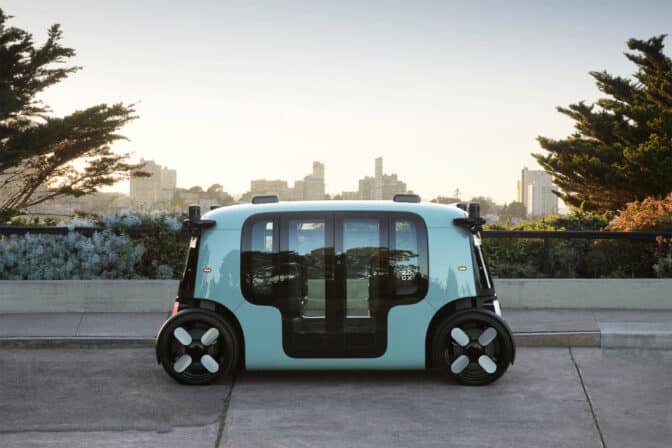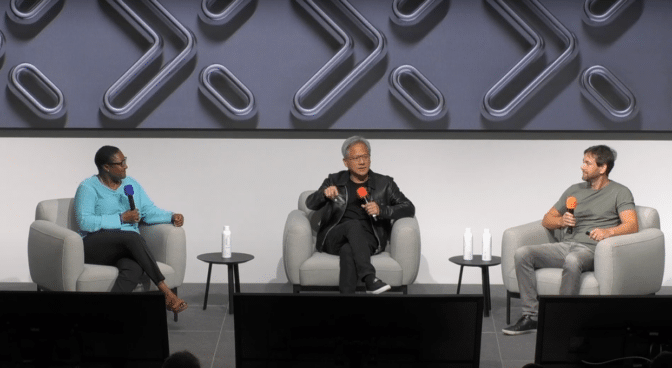To commemorate the 10th anniversary of Zoox, CEO Aicha Evans and CTO Jesse Levinson, along with NVIDIA’s founder and CEO Jensen Huang, engaged in a discussion on the latest advancements in autonomous vehicle (AV) technology. They also experienced a ride in the Zoox robotaxi.
During an engaging conversation at Zoox’s headquarters in Foster City, California, the three leaders reflected on the fruitful collaboration between the two companies. Evans and Levinson emphasized how Zoox was a trailblazer in introducing a robotaxi specifically designed for ride-hailing, achieving remarkable innovations with the assistance of NVIDIA’s technology.
Huang lauded Zoox, saying, “The world has never witnessed a robotics enterprise like Zoox before. Zoox began as a dedicated sustainable robotics firm that deploys robots into the world as a fleet.”
From 2014 onwards, Zoox has been dedicated to developing fully autonomous, bi-directional vehicles tailored for ride-hailing services, setting itself apart in an industry predominantly focused on retrofitting existing vehicles with self-driving capabilities.
A decade later, Zoox is now operating its cutting-edge robotaxi, powered by NVIDIA GPUs, on public roads.
The Core of Computational Power
The Zoox robotaxis effectively function as supercomputers on wheels, built on numerous NVIDIA GPUs dedicated to processing the vast amounts of real-time sensor data they generate.
The array of sensors includes cameras, lidar, radar, long-wave infrared sensors, and microphones. The onboard computing system swiftly processes the raw sensor data collected, fusing it to provide a coherent perception of the vehicle’s surroundings.
The processed data is then channeled through a perception engine and a prediction module to the planning and control systems, enabling the vehicle to navigate intricate urban environments safely.
NVIDIA GPUs supply the immense computational power required for the autonomous capabilities of Zoox’s robotaxis and ongoing learning from new scenarios.
Utilizing Simulation as a Digital Test Ground
Central to Zoox’s AV development process is its substantial use of simulation. The company leverages NVIDIA GPUs and software tools to conduct a broad spectrum of simulations, testing its autonomous systems in virtual environments prior to real-world implementation.
These simulations range from synthetic scenarios to replays of real-world situations formulated using data gathered from test vehicles. Zoox employs modified Toyota Highlanders outfitted with the same sensor and computing setups as its robotaxis to acquire driving data and validate its autonomous technology.
This data is then fed back into simulation environments, where it serves to create countless variations and replays of scenarios and agent interactions.
Zoox also integrates what it terms “adversarial simulations,” tailor-made scenarios designed to evaluate the capacities of the autonomous systems and uncover potential atypical scenarios.
The company’s holistic approach to simulation permits rapid refinement and enhancement of its autonomous driving software, enhancing AV safety and performance.
“Since our inception, we’ve been utilizing NVIDIA hardware,” stated Levinson. “It plays a major role in our simulator, and we heavily rely on NVIDIA GPUs in the vehicle to process real-time data around us.”
An Innovative Seating Concept
The Zoox robotaxi, with its distinctive bidirectional design and carriage-style seating arrangement, is tailored for autonomous functionality and passenger comfort, eliminating conventional distinctions of a car’s “front” and “back” to ensure equal comfort and safety for all passengers.
“When I visited you at your inception, the vision was compelling,” reminisced Huang about Zoox’s journey over the years. “The challenge was immense. The technology, the talent — all of it is top-tier.”
With the aid of NVIDIA GPUs and tools, Zoox aims to revolutionize urban mobility, spearheading a future of secure, efficient, and sustainable autonomous transport for all.
From Trial Drives to Market Predictions
As the AV sector gains momentum, recent forecasts indicate a significant growth potential in the robotaxi market. Guidehouse Insights predicts over 5 million robotaxi deployments by 2030, with projections reaching nearly 34 million by 2035.
The regulatory landscape mirrors this advancement, with 38 companies currently possessing valid licenses to test AVs with safety drivers in California. Zoox stands among the select six firms authorized to test AVs without safety drivers in the state.
As the sector progresses, Zoox has developed a next-gen robotaxi by amalgamating state-of-the-art onboard computing with extensive simulation and development efforts.
In the image above, NVIDIA founder and CEO Jensen Huang is pictured with Zoox CEO Aicha Evans and Zoox cofounder and CTO Jesse Levinson alongside a Zoox robotaxi.



